
The Dartford-Thurrock River Crossing, commonly known as the Dartford Crossing and until 1991 the Dartford Tunnel, is a major road crossing of the River Thames in England, carrying the A282 road between Dartford in Kent in the south and Thurrock in Essex in the north. It consists of two bored tunnels and the cable-stayed Queen Elizabeth II Bridge. The only fixed road crossing of the Thames east of Greater London, it is the busiest estuarial crossing in the United Kingdom, with an average daily use of over 130,000 vehicles. It opened in stages: the west tunnel in 1963, the east tunnel in 1980 and the bridge in 1991. The crossing, although not officially designated a motorway, is considered part of the M25 motorway's route, using the tunnels northbound and bridge southbound. Described as one of the most important road crossings in Britain, it suffers from heavy traffic and congestion.

The Tamar Bridge is a suspension bridge over the River Tamar between Saltash, Cornwall and Plymouth, Devon in southwest England. It is 335 metres (1,099 ft) long, running adjacent to the Royal Albert Bridge, and part of the A38, a main road between the two counties.
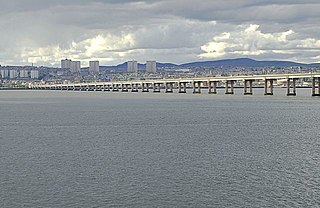
The Tay Road Bridge carries the A92 road across the Firth of Tay from Newport-on-Tay in Fife to Dundee in Scotland, just downstream of the Tay Rail Bridge. At around 2,250 metres (1.4 mi), it is one of the longest road bridges in Europe, and was opened in 1966, replacing the old Tay ferry.

The Humber Bridge, near Kingston upon Hull, East Riding of Yorkshire, England, is a 2.22 km single-span road suspension bridge, which opened to traffic on 24 June 1981. When it opened, the bridge was the longest of its type in the world; it was not surpassed until 1998, with the completion of the Akashi Kaikyō Bridge, and is now the eleventh-longest.

The River Trent is the third-longest river in the United Kingdom. Its source is in Staffordshire on the southern edge of Biddulph Moor. It flows through and drains most of the metropolitan central and northern Midlands south and east of its source north of Stoke-on-Trent. The river is known for dramatic flooding after storms and spring snowmelt, which in past times often caused the river to change course.

Gainsborough is a market town in the West Lindsey district of Lincolnshire, England. The population of the town was 20,842 at the 2011 census, and estimated at 23,243 in 2019. It lies on the east bank of the River Trent, 18 miles (29 km) north-west of the county town of Lincoln, 15 miles (24 km) south-west of Scunthorpe, and 35 miles (56 km) east of Sheffield. At one time it had important trade downstream to Hull, as the English port furthest inland – over 55 miles (90 km) from the North Sea.

The Bear Mountain Bridge, ceremonially named the Purple Heart Veterans Memorial Bridge, is a toll suspension bridge in New York State. It carries US 6 and US 202 across the Hudson River between Bear Mountain State Park in Orange County, less than a half mile north of the Rockland County line, and Cortlandt in Westchester County, less than a half mile south of the Putnam County line. At completion in 1924 it was longest suspension bridge in the world until this record was surpassed 19 months later by the Benjamin Franklin Bridge between Philadelphia and Camden, New Jersey. The Bear Mountain Bridge has an unconventional structure among suspension bridges; though the main span hangs from cables in the usual manner, the side spans leading to the approaches are suspended by their truss work, drawing no support from the cables above, similar to the Williamsburg Bridge in New York City.
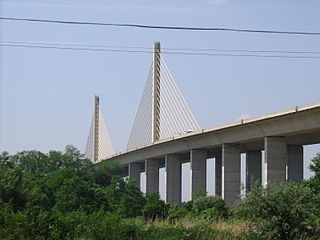
The Senator William V. Roth Jr. Bridge is a concrete and steel cable-stayed bridge that spans the Chesapeake & Delaware Canal near St. Georges, Delaware. The bridge is located near a tolled section of Delaware Route 1 that runs parallel to the St. Georges Bridge carrying U.S. Route 13. In November 2006, the bridge was named after U.S. Senator William V. Roth, Jr., who not only lent his name to the Roth IRA, but was instrumental in securing federal funding to build the bridge. It is owned and operated by the U.S. Army Corps of Engineers and does not carry a toll, despite the location of a nearby toll plaza.

The Dingmans Bridge is the last privately owned toll bridge on the Delaware River and one of the last few in the United States. It is owned and operated by the Dingmans Choice and Delaware Bridge Company.

The Lower Trenton Toll Supported Bridge, commonly called the Lower Free Bridge, Warren Street Bridge or Trenton Makes Bridge, is a two-lane Pennsylvania (Petit) through truss bridge over the Delaware River between Trenton, New Jersey and Morrisville, Pennsylvania, owned and operated by the Delaware River Joint Toll Bridge Commission (DRJTBC). It is known as the Trenton Makes Bridge because of large lettering on the south side reading "TRENTON MAKES THE WORLD TAKES", installed in 1935. In addition to being an important bridge from Pennsylvania to New Jersey, it is a major landmark in the city of Trenton. It is signed as US 1 Business, though does not officially carry that route.

The Severn Bridge is a motorway suspension bridge operated by Highways England that spans the River Severn and River Wye between Aust, South Gloucestershire in England, and Chepstow, Monmouthshire in South East Wales, via Beachley, Gloucestershire, which is a peninsula between the two rivers. It is the original Severn road crossing between England and Wales, and took three-and-a-half years to construct at a cost of £8 million. It replaced the 137 years old Aust Ferry.

The Delaware River–Turnpike Toll Bridge is a four-lane, steel through arch bridge crossing the Delaware River between Burlington Township, Burlington County, New Jersey and Bristol Township, Bucks County, Pennsylvania. As a part of Interstate 95, it is a major highway link between Philadelphia and New York City. The bridge also connects the Pennsylvania Turnpike's east-west mainline with the main trunk of the New Jersey Turnpike, via the Pearl Harbor Memorial Turnpike Extension. Tolls are collected only in the west/southbound direction via electronic toll collection.
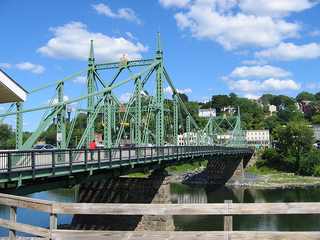
The Northampton Street Bridge is a bridge that crosses the Delaware River, connecting Easton, Pennsylvania, and Phillipsburg, New Jersey, United States. It is maintained by the Delaware River Joint Toll Bridge Commission despite not being a toll bridge. It is known locally as the "Free Bridge" thus distinguishing it from the Easton–Phillipsburg Toll Bridge just upstream to the north. The crossing was first a ferry crossing run by David Martin, beginning in 1739.

The Cornish–Windsor Covered Bridge is a 154-year-old, two-span, timber Town lattice-truss, interstate, covered bridge that crosses the Connecticut River between Cornish, New Hampshire, and Windsor, Vermont. Until 2008, when the Smolen–Gulf Bridge opened in Ohio, it had been the longest covered bridge in the United States.
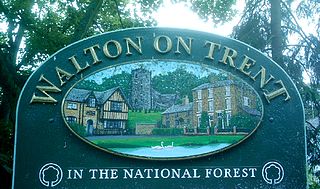
Walton-on-Trent is a village and civil parish in the National Forest in Derbyshire, England. The population of the civil parish as taken at the 2011 Census was 872. As its name implies it is an ancient crossing point of the River Trent. It was at this point that King Edward II crossed the river in pursuit of the disaffected barons including the Earl of Lancaster. Listed buildings in the parish include Catton Hall, Walton Hall and The Old Hall house. Today the village is very close to Burton upon Trent).
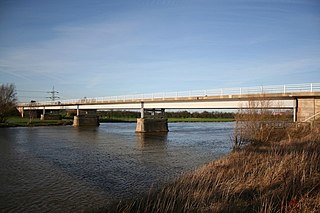
Dunham Bridge is a toll bridge across the River Trent in England. It spans the border between the administrative counties of Nottinghamshire and Lincolnshire to the west and east respectively. It forms part of the A57 road, in the section between the Great North Road and Lincoln. It takes its name from the nearby village of Dunham-on-Trent.
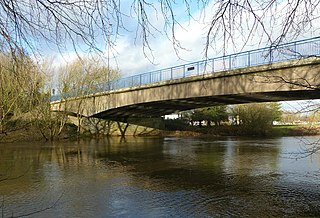
Cavendish Bridge is a bridge over the River Trent, connecting the counties of Leicestershire and Derbyshire; it is also the name of a hamlet on the Leicestershire side of the river within the Castle Donington parish. This bridge once carried the main London-Manchester turnpike, though the modern A6/A50 dual carriageway has now been built to the south bypassing the crossing.

Harrington Bridge crosses the River Trent near Sawley in Derbyshire carrying the Tamworth Road (B6540) into Leicestershire. The stonework of the bridge dates from 1790, but the central section was replaced in 1905 after it was damaged by flood water. The central section is the only part of the bridge that is not a listed building.

Keadby Bridge, more formally known as the King George V Bridge, crosses the River Trent near Althorpe and Keadby in Lincolnshire, England. It was designed by Alfred Charles Gardner FRSE MIME.
William Weston was a civil engineer who worked in England and the United States of America. For a brief period at the end of the 18th century, Weston was the pre-eminent civil engineer in the new United States and worked on the Schuylkill and Susquehanna Navigation Company, the Western and Northern Inland Lock Navigation Companies in New York, the Middlesex canal in Massachusetts, the Schuylkill Permanent Bridge at Philadelphia, Pennsylvania and the Potomac navigation.




















